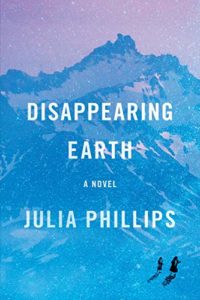I recently read Disappearing Earth by Julia Phillips. It was on my TBR lottery because I was interested in reading a book that took place in Russia. The book has won a few awards, but the story itself didn’t really excite me. There were some parts of this story I loved though.
Disappearing Earth fills the slot for contemporary Russia in my Read Around the World Challenge. So far I’ve read contemporary books from 5 countries, so I have a long way to go still.
This is the story of two little girls that disappear on the Kamchatka Peninsula in Russia. It gets into the heads of several different but connected people living in the area. All were affected by this tragedy. The book covers the community for the year after these children go missing.
What I Liked
What I liked about this book primarily had to do with its unique Russian setting. The Kamchatka Peninsula, in case you don’t know, is located on the Eastern coast of Russia, about as far away from Moscow and Saint Petersberg as you can get. While those two cities are quite European, Russia is a huge country and most of its landmass is located in Asia. It also has a very large native population, which reminds me a lot of the Native American population in the United States. Disappearing Earth immerses the reader into this little corner of the world which I haven’t seen too many books about.
The book also briefly touches prejudices that people throughout the world have about “the other.” When the girls go missing, some of whom we’d view as the “typical European Russian” type blame the natives, or people who immigrated to the peninsula after the fall of the Soviet Union. It was interesting to see how people in multiple cultures tend to have the same problems in this way.
What I Didn’t Care For
I didn’t care for the way this story was told. Each chapter is viewed through the eyes of a different narrator. As a result, I never had the chance to become attached to any one person. Their lives pretty much sucked too, and most of them weren’t likeable. Most of them were breaking up with their boyfriends or husbands, cheating on their boyfriends, or making their children stay away from “bad influences” that might have only one parent around most of the time. The one sympathetic character was the little girl whose best friend wasn’t allowed to speak to her anymore. I might have felt a little sympathy for the lady that lost her dog, but then she acted like a total witch, breaking any care I had for her. After reading this book, I’m certainly not going to rush out to find a Kamchatkan pen pal.
In many of these chapters, the characters had something they were dealing with, like a potential tumor or the missing dog or the loss of their friend, and I might want to find out what happened to them. However, each character only has one chapter from their point of view, so you never get to find out what happened to them. Another character might mention them in passing, but we never find out how their situations resolved.
Conclusion
I liked the ending. We do get to find out in the end what happened to the girls (yay!). The setting was great. However, the story itself: the characters, the situations that happened to them, etc., really didn’t draw me in. If you’re reading the book for the unique Kamchatka setting, then you might like it. I find it sad that I couldn’t really click with the characters and their situations.
